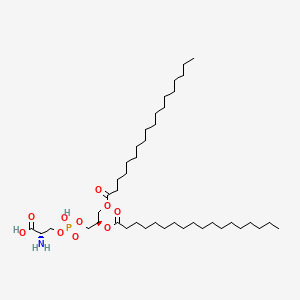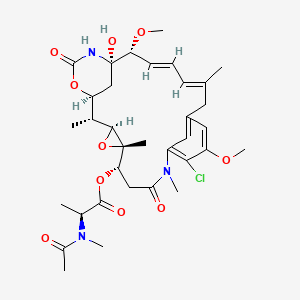
|
PE(15:0/20:0) |
PE(15:0/20:0) is a lipid of Glycerophospholipids (GP) class. Pe(15:0/20:0) is associated with abnormalities such as Exanthema, Infection, Painful Bladder Syndrome, Obesity and Fatty Liver. The involved functions are known as conjugation, Transcription, Genetic, Sinking, Autophagy and Protein Biosynthesis. Pe(15:0/20:0) often locates in membrane fraction, soluble, Membrane, Body tissue and Tissue membrane. The associated genes with PE(15:0/20:0) are GABARAPL2 gene, ATG10 gene, ATG12 gene, SLC33A1 gene and GABARAP gene. The related lipids are Liposomes, Lipopolysaccharides, Phosphatidylserines, Membrane Lipids and Cardiolipins. The related experimental models are Knock-out and Cancer Model. |
723 |

|
51446-62-9 |
51446-62-9 is a lipid of Glycerophospholipids (GP) class. 51446-62-9 is associated with abnormalities such as Virus Diseases, Infection, Bacterial Infections, Communicable Diseases and Exanthema. The involved functions are known as Phagocytosis, Obstruction, Binding (Molecular Function), targeting and inhibitors. 51446-62-9 often locates in Head, Clone, Cell membrane, Cell surface and host. The associated genes with 51446-62-9 are Homologous Gene, Orthologous Gene, Fusion Protein, ETV3 gene and Amino Acids, Basic. The related lipids are Phosphatidylserines, Lipopolysaccharides, 1-palmitoyl-2-oleoylphosphatidylethanolamine, beta-amyrin and Membrane Lipids. |
1744 |

|
1-Oleoyl Lysophosphatidic Acid |
1-Oleoyl Lysophosphatidic Acid is a lipid of Glycerophospholipids (GP) class. 1-oleoyl lysophosphatidic acid is associated with abnormalities such as Myocardial Infarction, early pregnancy, Scleroderma, Blind Vision and Hyperlipidemia. The involved functions are known as Agent, Blood coagulation, Selection, Genetic, Analyte and Biological Processes. 1-oleoyl lysophosphatidic acid often locates in Tissue specimen, Body tissue, Blood, Membrane and Skin. The associated genes with 1-Oleoyl Lysophosphatidic Acid are Mucin-16, Peptides, SMAD4 gene, RND1 gene and Polypeptides. The related lipids are lysophosphatidic acid, A(2)C, Lysophospholipids, Fatty Acids and sphingosine 1-phosphate. The related experimental models are Mouse Model, Knock-out, Cancer Model, Xenograft Model and Arthritis, Adjuvant-Induced. |
3463 |

|
lysophosphatidic acid |
lysophosphatidic acid is a lipid of Glycerophospholipids (GP) class. Lysophosphatidic acid is associated with abnormalities such as Atherosclerosis, Alzheimer's Disease, Asthma, Diabetes Mellitus, Non-Insulin-Dependent and Septicemia. The involved functions are known as Inflammation, Chemotaxis, Binding (Molecular Function), Polymerization and Inflammatory Response. Lysophosphatidic acid often locates in Cytoskeleton, Microfilaments, actin cytoskeleton, Extracellular and Structure of germinal center of lymph node. The associated genes with lysophosphatidic acid are TNF gene, MAPK3 gene, RHOA gene, CDC42 gene and ADRBK1 gene. The related lipids are lysophosphatidic acid, Lipopolysaccharides, Lysophosphatidylcholines, Lysophospholipids and Phosphatidic Acid. The related experimental models are Knock-out, Transgenic Model, Rodent Model and Disease model. |
820 |

|
trichostatin A |
Trichostatin is a lipid of Polyketides (PK) class. Trichostatin is associated with abnormalities such as Dentatorubral-Pallidoluysian Atrophy, PARAGANGLIOMAS 3, abnormal fragmented structure, Disintegration (morphologic abnormality) and Hyperostosis, Diffuse Idiopathic Skeletal. The involved functions are known as Acetylation, Cell Differentiation process, histone modification, Gene Silencing and Transcriptional Activation. Trichostatin often locates in CD41a, Hematopoietic System, Chromatin Structure, Blood and Endothelium. The associated genes with Trichostatin are SPI1 gene, CELL Gene, Chromatin, CXCR4 gene and DNMT1 gene. The related lipids are Butyrates, Promega, butyrate, Lipopolysaccharides and Steroids. The related experimental models are Knock-out, Mouse Model, Xenograft Model and Cancer Model. |
5401 |

|
clarithromycin |
clarithromycin is a lipid of Polyketides (PK) class. Clarithromycin is associated with abnormalities such as Helicobacter Pylori Infection, Infection, Coinfection, Gastritis and Peptic Ulcer. The involved functions are known as Point Mutation, Increased Sensitivy, Bacterial resistance, urease activity and Mutation. Clarithromycin often locates in Blood, Gastric mucosa, Biopsy sample, Respiratory System and Entire gastrointestinal tract. The associated genes with clarithromycin are Genes, rRNA, rRNA Operon, Genome, HM13 gene and GDF15 gene. The related lipids are 9,11-linoleic acid, Steroids, Lysophosphatidylcholines, Lipopolysaccharides and 4-hydroxycholesterol. The related experimental models are Mouse Model, Knock-out and Experimental Pneumococcal Meningitis. |
10449 |

|
MAYTANSINE |
MAYTANSINE is a lipid of Polyketides (PK) class. Maytansine is associated with abnormalities such as Myelosuppression and BOSLEY-SALIH-ALORAINY SYNDROME. The involved functions are known as Mutation, Agent, Polymerization, Cell Cycle Arrest and Drug Kinetics. Maytansine often locates in Cytoplasm, Hepatic, Lysosomes, Cell surface and Microtubules. The associated genes with MAYTANSINE are ABCB1 gene, HM13 gene, CNN1 gene, CYP2C8 gene and CYP2D6 gene. The related lipids are Valerates. The related experimental models are Xenograft Model. |
984 |

|
minocycline |
minocycline is a lipid of Polyketides (PK) class. Minocycline is associated with abnormalities such as Infection, Soft Tissue Infections, Septicemia, Chronic hyponatremia and Lesion of brain. The involved functions are known as Pharmacodynamics, Gene Expression, Transcriptional Activation, Regulation and Process. Minocycline often locates in Ribosomes, 50S ribosomal subunit, Blood, Skin and Immune system. The associated genes with minocycline are THEMIS gene, KCNK2 gene, RBFOX3 gene, PIWIL2 gene and P4HTM gene. The related lipids are Lipopolysaccharides, Promega, Steroids, Liposomes and Octanols. The related experimental models are Mouse Model, Experimental Autoimmune Encephalomyelitis, Genetically Engineered Mouse, Disease model and spinal model. |
9780 |

|
oxytetracycline |
oxytetracycline is a lipid of Polyketides (PK) class. Oxytetracycline is associated with abnormalities such as Infection, X-linked centronuclear myopathy, Bacterial Infections, Heart failure and Onchocerciasis. The involved functions are known as Anabolism, physiological aspects, Transcription, Genetic, Fermentation and Transcriptional Activation. Oxytetracycline often locates in Chromosomes, Flank (surface region), Entire bony skeleton, Bone Marrow and Body tissue. The associated genes with oxytetracycline are Polypeptides, Homologous Gene, Gene Clusters, Locus and CYCS gene. The related lipids are LH 1 and Lipid Peroxides. The related experimental models are Disease model. |
6787 |

|
CYTOCHALASIN B |
CYTOCHALASIN B is a lipid of Polyketides (PK) class. Cytochalasin b is associated with abnormalities such as Renal tubular disorder and Chagas Disease. The involved functions are known as Membrane Protein Traffic, inhibitors, Metabolic Inhibition, Biochemical Pathway and Increased Sensitivy. Cytochalasin b often locates in Cytoplasmic matrix, Plasma membrane, Microtubules, Extracellular and Protoplasm. The associated genes with CYTOCHALASIN B are SLC2A2 gene, PFDN5 gene, SLC2A1 gene, OMG gene and SPEN gene. The related lipids are Steroids, Lipopolysaccharides and Liposomes. The related experimental models are Xenograft Model. |
9648 |









